Identification of Impact Frequency for Down-the-Hole Drills Using Motor Current Signature Analysis
Abstract
1. Introduction
2. Materials and Methods
2.1. Principles of Percussion DTH Drilling
2.2. DTH Drilling Setup
2.3. Characterization of Drilling Stages
2.4. Identification of Impact Frequency Using Hammer Pressure and Sound Signals
3. Results
3.1. Side Bands Approach
3.2. Waterfall Plots Approach
3.3. Envelope Approach
4. Discussion
5. Conclusions
Author Contributions
Funding
Institutional Review Board Statement
Informed Consent Statement
Data Availability Statement
Conflicts of Interest
References
- Bruno, M.S. Fundamental Research on Percussion Drilling: Improved Rock Mechanics Analysis, Advanced Simulation Technology, and Full-Scale Laboratory Investigations; Technical Report; Office of Scientific and Technical Information, Department of Energy: Arcadia, CA, USA, 2005. [CrossRef]
- Chiang, L.E.; Stamm, E.B. Design Optimization of Valveless DTH Pneumatic Hammers by a Weighted Pseudo-Gradient Search Method. J. Mech. Des. 1998, 120, 687–694. [Google Scholar] [CrossRef]
- Zhang, Z.X. Rock Fracture and Blasting: Theory and Applications; Butterworth-Heinemann: Oxford, UK, 2016. [Google Scholar]
- Li, J.G.; Zhan, K. Intelligent Mining Technology for an Underground Metal Mine Based on Unmanned Equipment. Engineering 2018, 4, 381–391. [Google Scholar] [CrossRef]
- Bo, K.; Chen, B.; Hu, Y.; Wang, M. Design optimization and feasibility analysis of pneumatic DTH Hammer with self-rotation bit. J. Vibroengineering 2022, 24, 305–316. [Google Scholar] [CrossRef]
- Izquierdo, L.E.; Chiang, L.E. A methodology for estimation of the specific rock energy index using corrected down-the-hole drill monitoring data. Min. Technol. 2004, 113, 225–236. [Google Scholar] [CrossRef]
- Karpov, V.N.; Petreev, A.M. Determination of Efficient Rotary Percussive Drilling Techniques for Strong Rocks. J. Min. Sci. 2021, 57, 447–459. [Google Scholar] [CrossRef]
- Chiang, L.; Elías, D. Modeling impact in down-the-hole rock drilling. Int. J. Rock Mech. Min. Sci. 2000, 37, 599–613. [Google Scholar] [CrossRef]
- Bu, C.; Qu, Y.; Cheng, Z.; Liu, B. Numerical simulation of impact on pneumatic DTH hammer percussive drilling. J. Earth Sci. 2009, 20, 868–878. [Google Scholar] [CrossRef]
- Zhu, X.; Tang, L.; Tong, H. Effects of High-Frequency Torsional Impacts on Rock Drilling. Rock Mech. Rock Eng. 2014, 47, 1345–1354. [Google Scholar] [CrossRef]
- Wang, Y.; Ni, H.; Wang, R.; Huang, B.; Liu, S.; Zhang, H. Numerical Simulation Research on Cutting Rock with a PDC Cutter Assisted by an Impact Force. Adv. Civ. Eng. 2022, 2022, 8282104. [Google Scholar] [CrossRef]
- Ma, Y.; Xu, Y. Research into technology for precision directional drilling of gas-drainage boreholes. Min. Miner. Depos. 2022, 16, 27–32. [Google Scholar] [CrossRef]
- Liu, H. Numerical Modelling of the Rock Fragmentation Process by Mechanical Tools. Ph.D. Thesis, Luleå University of Technology, Luleå, Sweden, 2004. [Google Scholar]
- Kivade, S.; Murthy, C.S.; Vardhan, H. Experimental Investigations on Penetration Rate of Percussive Drill. Procedia Earth Planet. Sci. 2015, 11, 89–99. [Google Scholar] [CrossRef]
- López Jimeno, C.; López Jimeno, E.; García Bermúdez, P. Manual de Perforación y Voladura de Rocas, 1st ed.; Instituto Tecnológico Geominero de España: Madrid, Spain, 2003. [Google Scholar]
- Bout, G.; Brito, D.; Gómez, R.; Carvajal, G.; Ramírez, G. Physics-Based Observers for Measurement-While-Drilling System in Down-the-Hole Drills. Mathematics 2022, 10, 4814. [Google Scholar] [CrossRef]
- Zhao, Z.; Meng, Y.; Li, Y.; Shi, X.; Xiang, C. Effects of Working Angle on Pneumatic Down-the-hole Hammer Drilling. Rock Mech. Rock Eng. 2015, 48, 2141–2155. [Google Scholar] [CrossRef]
- Shi, H.; Ji, Z.; Jiang, J.; Li, B. Numerical Study on Fragmentation Characteristics of Granite Under a Single Polycrystalline Diamond Compact Cutter in Rotary-Percussive Drilling. J. Energy Resour. Technol. 2022, 144, 093201. [Google Scholar] [CrossRef]
- Lianggang, L.; Bing, Z.; Qiang, L. Study on Vibration Frequency and Rock Fragmentation Effect of Sonic Drill Rig. Procedia Eng. 2014, 73, 3–9. [Google Scholar] [CrossRef]
- Guo, Y.; Yang, S.Y.; Liu, D.S.; Zhang, L.Y.; Chen, J.W. Impact performance for high frequency hydraulic rock drill drifter with sleeve valve. Int. J. Fluid Mach. Syst. 2016, 9, 39–46. [Google Scholar] [CrossRef]
- Zhang, X.; Zhang, S.; Peng, J.; Wu, D. A fluidic oscillator with concave attachment walls and shorter splitter distance for fluidic DTH hammers. Sens. Actuators A Phys. 2018, 270, 127–135. [Google Scholar] [CrossRef]
- Bharathan, B.; Sasmito, A.P.; Ghoreishi-Madiseh, S.A. Analysis of energy consumption and carbon footprint from underground haulage with different power sources in typical Canadian mines. J. Clean. Prod. 2017, 166, 21–31. [Google Scholar] [CrossRef]
- Fúnez Guerra, C.; Reyes-Bozo, L.; Vyhmeister, E.; Jaén Caparrós, M.; Salazar, J.; Godoy-Faúndez, A.; Clemente-Jul, C.; Verastegui-Rayo, D. Viability analysis of underground mining machinery using green hydrogen as a fuel. Int. J. Hydrogen Energy 2020, 45, 5112–5121. [Google Scholar] [CrossRef]
- Ertugrul, N.; Kani, A.P.; Davies, M.; Sbarbaro, D.; Morán, L. Status of Mine Electrification and Future Potentials. In Proceedings of the 2020 International Conference on Smart Grids and Energy Systems (SGES), Perth, Australia, 23–26 November 2020; pp. 151–156. [Google Scholar] [CrossRef]
- Paraszczak, J.; Svedlund, E.; Fytas, K.; LaFlamme, M. Electrification of Loaders and Trucks – A Step Towards More Sustainable Underground Mining. Renew. Energy Power Qual. J. 2014, 1, 81–86. [Google Scholar] [CrossRef]
- Nieto, A.; Schatz, R.; Dogruoz, C. Performance analysis of electric and diesel equipment for battery replacement of tethered LHD vehicles in underground mining. Min. Technol. 2020, 129, 1–8. [Google Scholar] [CrossRef]
- Hassan, O.E.; Amer, M.; Abdelsalam, A.K.; Williams, B.W. Induction motor broken rotor bar fault detection techniques based on fault signature analysis—A review. IET Electr. Power Appl. 2018, 12, 895–907. [Google Scholar] [CrossRef]
- Antonino-Daviu, J.A.; Gyftakis, K.N.; Garcia-Hernandez, R.; Razik, H.; Marques Cardoso, A.J. Comparative Influence of Adjacent and Non-Adjacent Broken Rotor Bars on the Induction Motor Diagnosis through MCSA and ZSC Methods. In Proceedings of the IECON 2015-41st Annual Conference of the IEEE Industrial Electronics Society, Yokohama, Japan, 9–12 November 2015; pp. 001680–001685. [Google Scholar] [CrossRef]
- Noureddine, B.; Eddine, Z.S.; Mohamed, S. Experimental Exploitation for the Diagnosis to the Induction Machine under a Bearing Fault-Using MCSA. In Proceedings of the 2015 4th International Conference on Electrical Engineering (ICEE), Boumerdes, Algeria, 13–15 December 2015; pp. 1–4. [Google Scholar] [CrossRef]
- Pandarakone, S.E.; Masuko, M.; Mizuno, Y.; Nakamura, H. Deep Neural Network Based Bearing Fault Diagnosis of Induction Motor Using Fast Fourier Transform Analysis. In Proceedings of the 2018 IEEE Energy Conversion Congress and Exposition (ECCE), Portland, OR, USA, 23–27 December 2018; pp. 3214–3221. [Google Scholar] [CrossRef]
- Bessous, N.; Zouzou, S.E.; Sbaa, S.; Bentrah, W. A Comparative Study between the MCSA, DWT and the Vibration Analysis Methods to Diagnose the Dynamic Eccentricity Fault in Induction Motors. In Proceedings of the 2017 6th International Conference on Systems and Control (ICSC), Batna, Algeria, 7–9 May 2017; pp. 414–421. [Google Scholar] [CrossRef]
- Bessous, N.; Zouzou, S.E.; Sbaa, S.; Khelil, A. New Vision about the Overlap Frequencies in the MCSA-FFT Technique to Diagnose the Eccentricity Fault in the Induction Motors. In Proceedings of the 2017 5th International Conference on Electrical Engineering—Boumerdes (ICEE-B), Boumerdes, Algeria, 29–31 October 2017; pp. 1–6. [Google Scholar] [CrossRef]
- Akhil Vinayak, B.; Anjali Anand, K.; Jagadanand, G. Wavelet-based real-time stator fault detection of inverter-fed induction motor. IET Electr. Power Appl. 2020, 14, 82–90. [Google Scholar] [CrossRef]
- Bazan, G.H.; Scalassara, P.R.; Endo, W.; Goedtel, A.; Godoy, W.F.; Palácios, R.H.C. Stator fault analysis of three-phase induction motors using information measures and artificial neural networks. Electr. Power Syst. Res. 2020, 143, 1–8. [Google Scholar] [CrossRef]
- Yakhni, M.F.; Cauet, S.; Sakout, A.; Assoum, H.; Etien, E.; Rambault, L.; El-Gohary, M. Variable speed induction motor’s fault detection based on transient motor current signatures analysis: A review. Mech. Syst. Signal Process. 2020, 184, 109737. [Google Scholar] [CrossRef]
- dSPACE. Brochure MicroLabBox Hardware. 2020. Available online: https://www.dspace.com/shared/data/pdf/2020/dSPACE-MicroLabBox_Product-Brochure_2020-01_EN.pdf (accessed on 29 January 2023).
- Thomson, W.T.; Culbert, I. Current Signature Analysis for Condition Monitoring of Cage Induction Motors: Industrial Application and Case Histories, 1st ed.; Wiley: Hoboken, NJ, USA, 2016. [Google Scholar] [CrossRef]
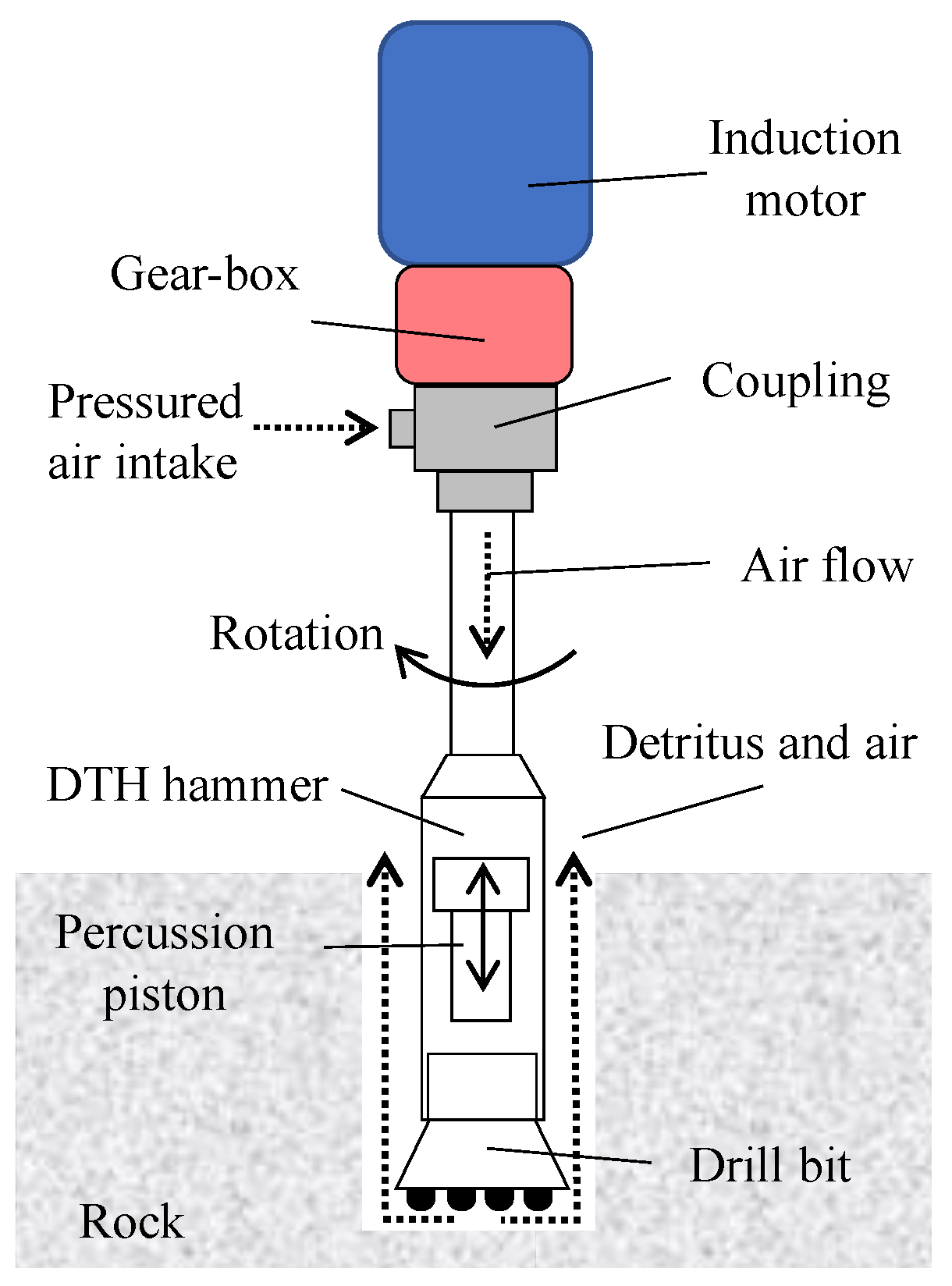
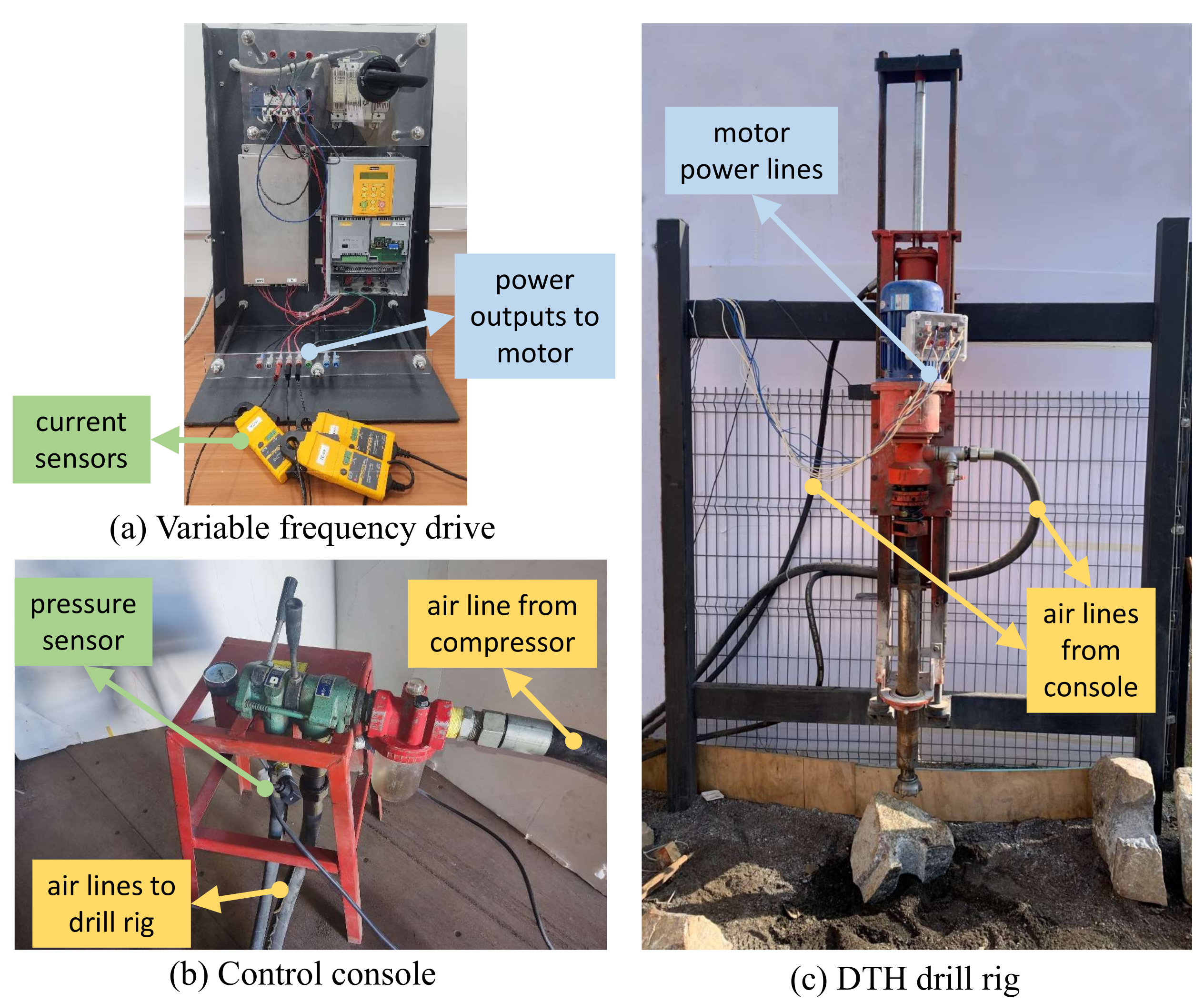
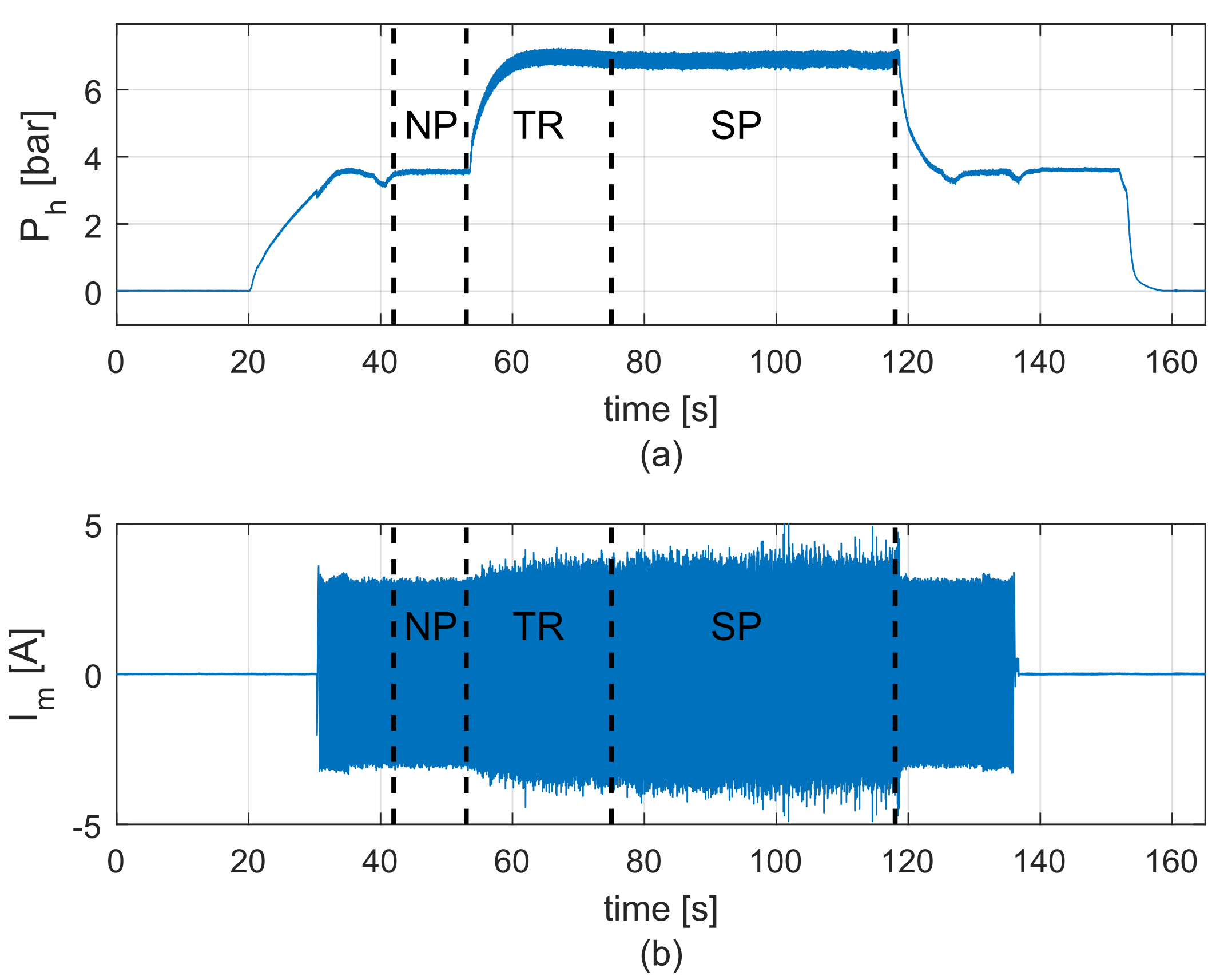
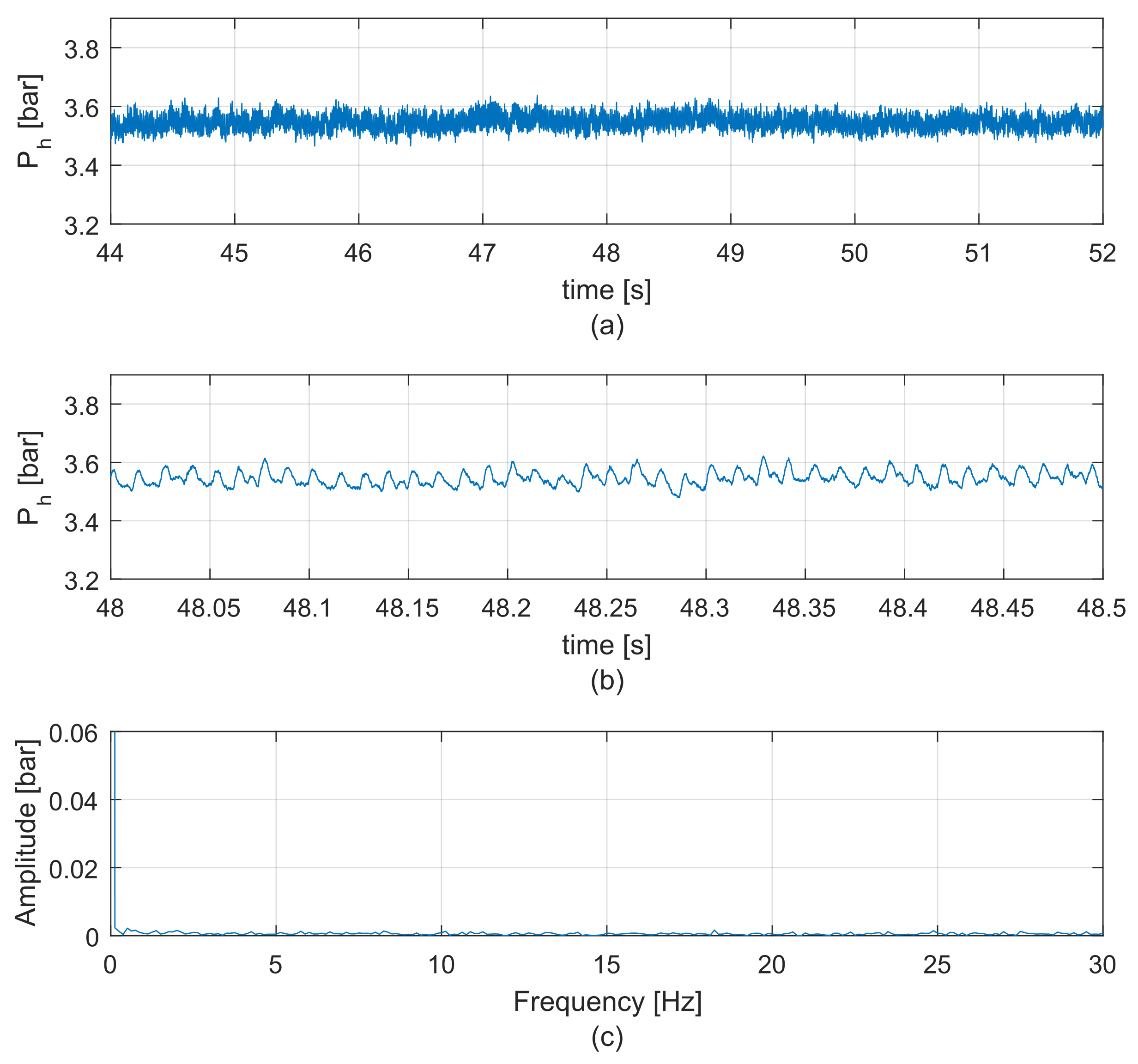
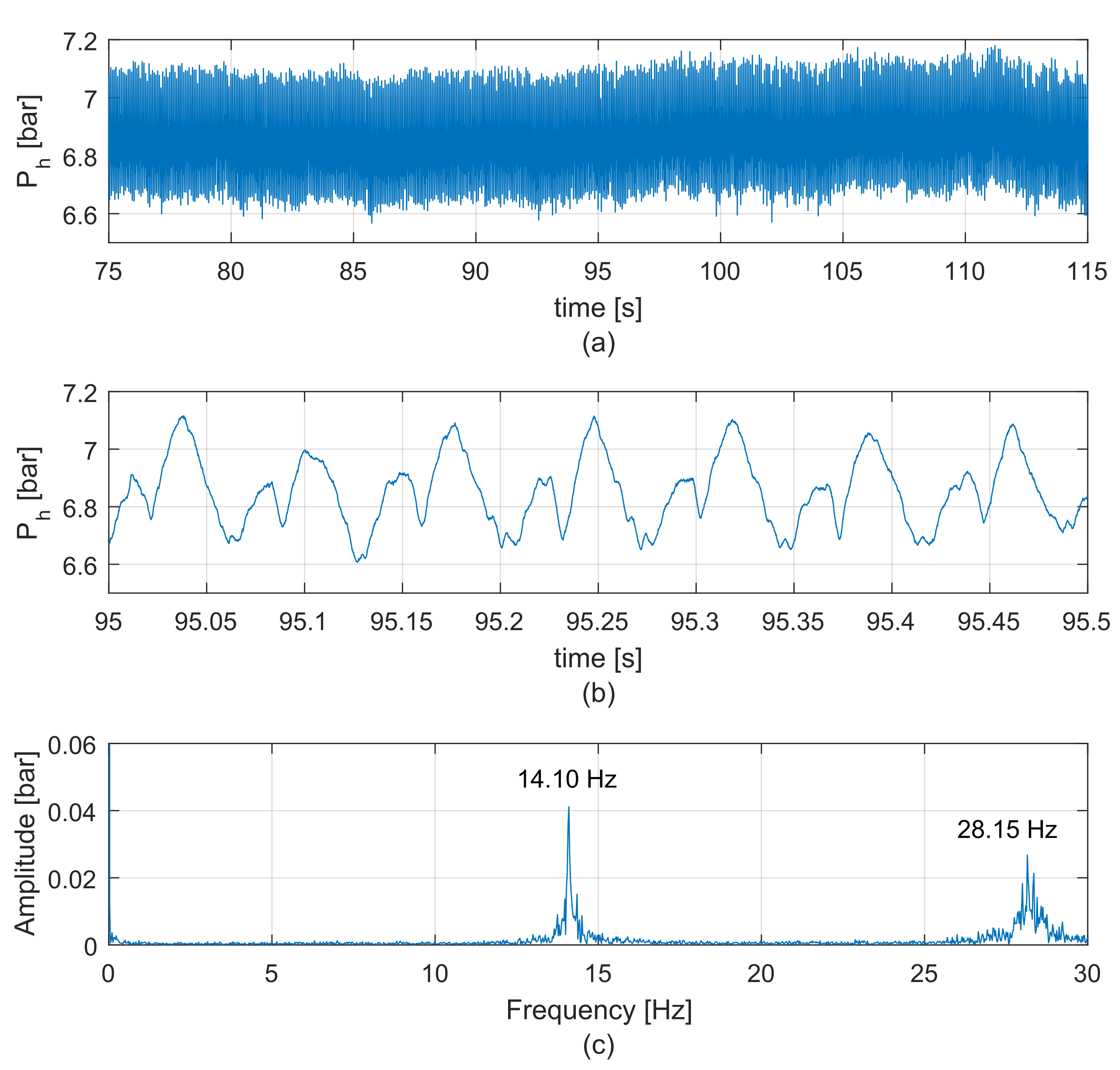

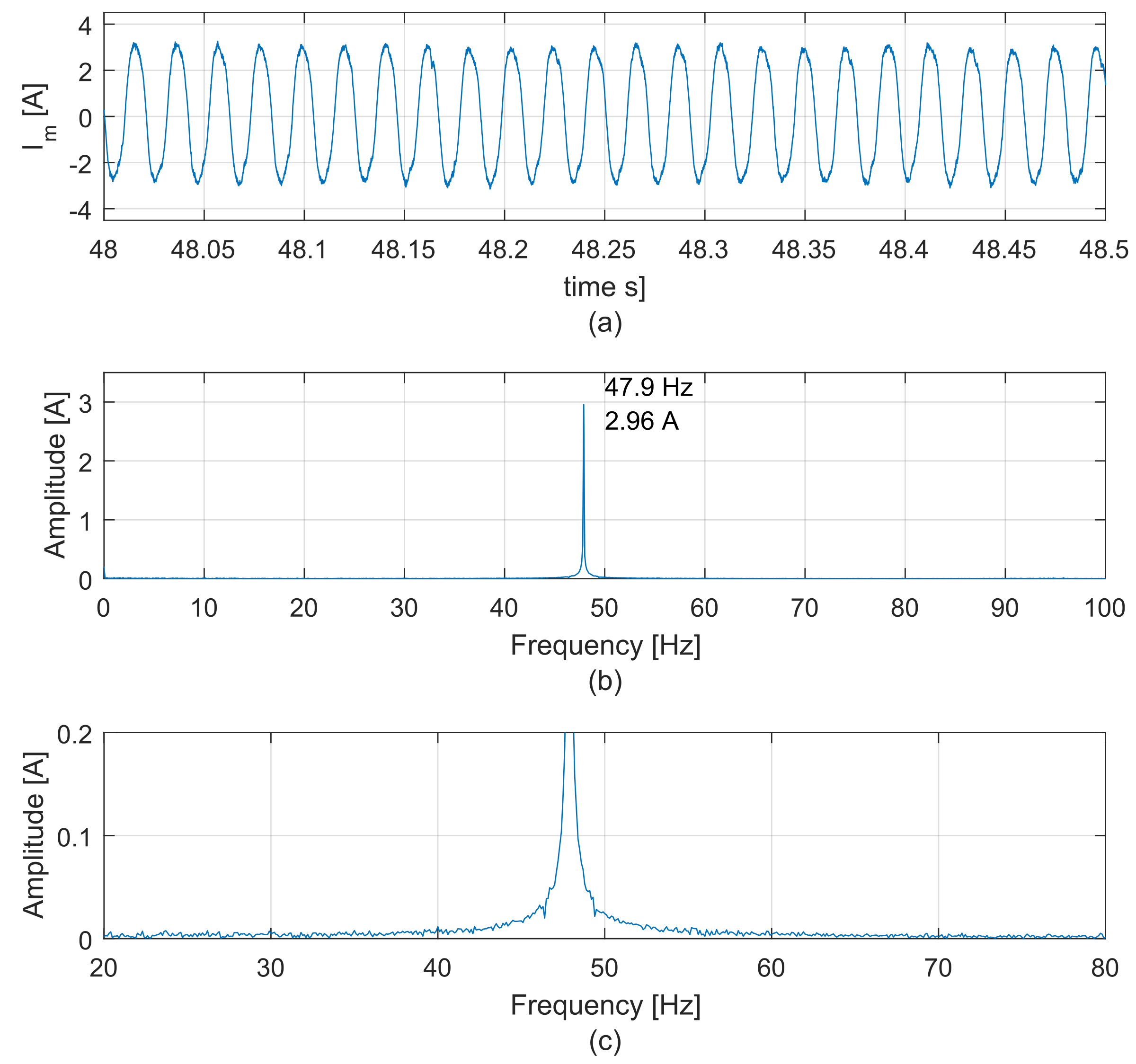



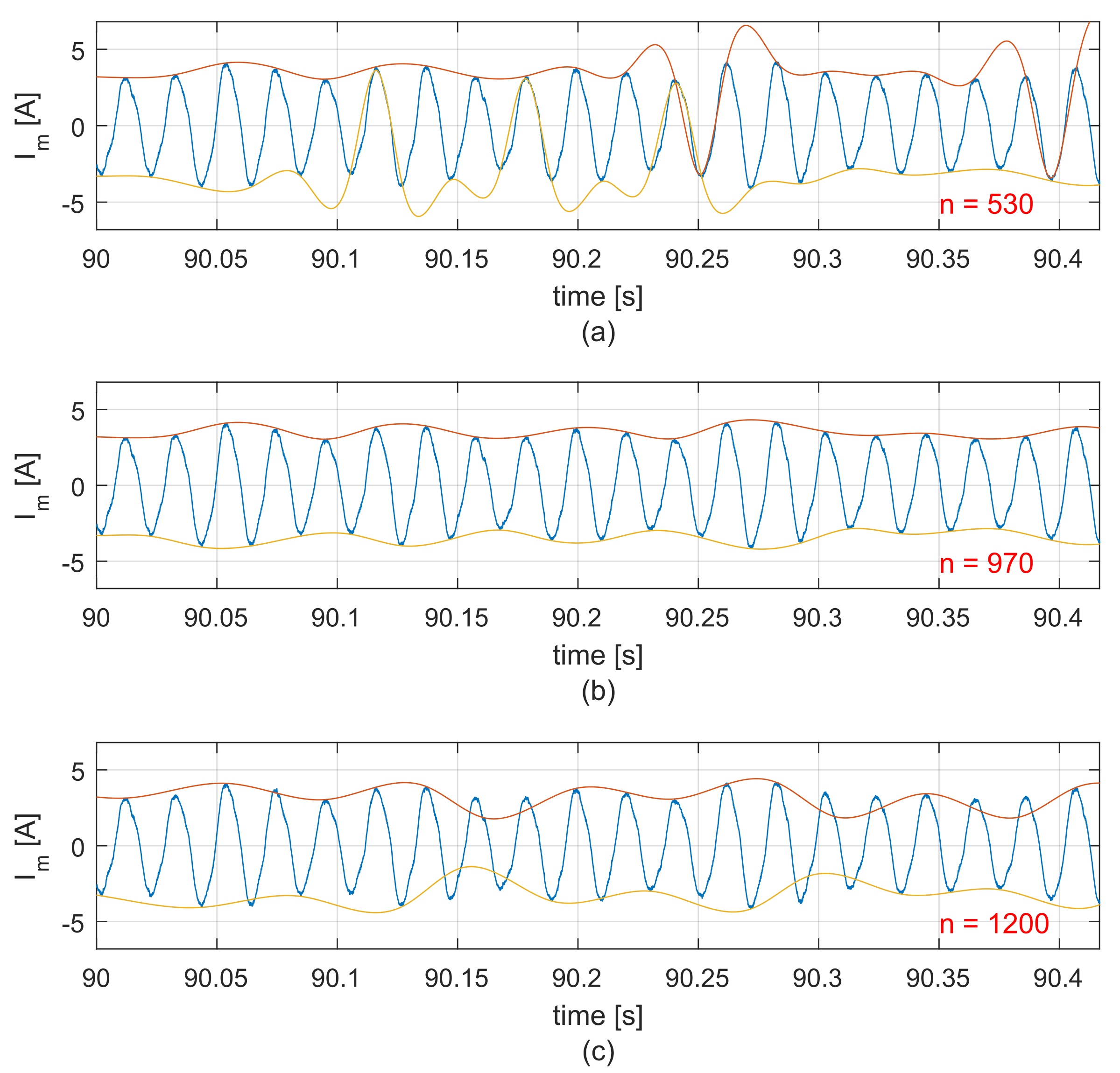
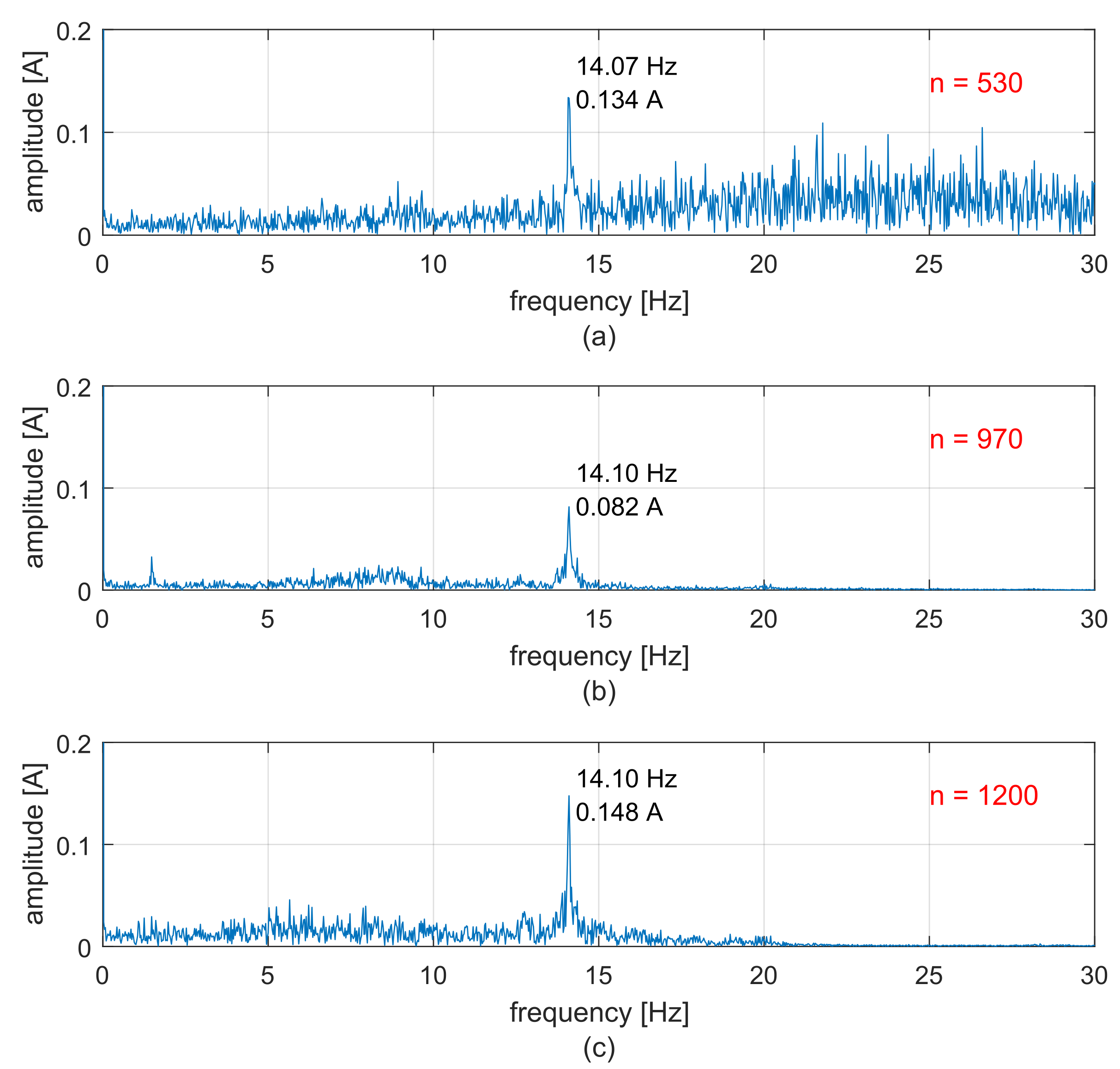
| Sensor Type | Range | Output | Bandwidth |
|---|---|---|---|
| Current clamp | DC + AC peak: 30 [A] | ±100 [mV/A] | 20 [kHz] |
| Hammer pressure | 0–10 [bar] | 0–10 [V] | 1 [kHz] |
Disclaimer/Publisher’s Note: The statements, opinions and data contained in all publications are solely those of the individual author(s) and contributor(s) and not of MDPI and/or the editor(s). MDPI and/or the editor(s) disclaim responsibility for any injury to people or property resulting from any ideas, methods, instructions or products referred to in the content. |
© 2023 by the authors. Licensee MDPI, Basel, Switzerland. This article is an open access article distributed under the terms and conditions of the Creative Commons Attribution (CC BY) license (https://creativecommons.org/licenses/by/4.0/).
Share and Cite
Brito, D.; Gómez, R.; Carvajal, G.; Reyes-Chamorro, L.; Ramírez, G. Identification of Impact Frequency for Down-the-Hole Drills Using Motor Current Signature Analysis. Appl. Sci. 2023, 13, 4650. https://doi.org/10.3390/app13084650
Brito D, Gómez R, Carvajal G, Reyes-Chamorro L, Ramírez G. Identification of Impact Frequency for Down-the-Hole Drills Using Motor Current Signature Analysis. Applied Sciences. 2023; 13(8):4650. https://doi.org/10.3390/app13084650
Chicago/Turabian StyleBrito, Diego, René Gómez, Gonzalo Carvajal, Lorenzo Reyes-Chamorro, and Guillermo Ramírez. 2023. "Identification of Impact Frequency for Down-the-Hole Drills Using Motor Current Signature Analysis" Applied Sciences 13, no. 8: 4650. https://doi.org/10.3390/app13084650
APA StyleBrito, D., Gómez, R., Carvajal, G., Reyes-Chamorro, L., & Ramírez, G. (2023). Identification of Impact Frequency for Down-the-Hole Drills Using Motor Current Signature Analysis. Applied Sciences, 13(8), 4650. https://doi.org/10.3390/app13084650








